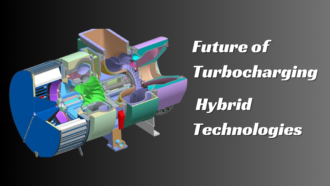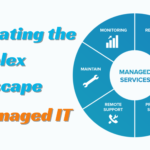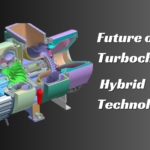Streamline Your Application Modernization Journey with Containerization
- 1 What is Containerization?
- 2 Why Containerization Matters in Application Modernization?
- 2.1 Streamlining the Application Modernization Journey with Containerization
- 2.2 Evaluate current application architecture
- 2.3 Choose container orchestration platform
- 2.4 Create containerization strategy
- 2.5 Start small and iterate
- 2.6 Automate the containerization process
- 2.7 Ensure security and compliance
- 2.8 Monitor and Optimize Container Performance
- 3 Benefits of Containerization in Application Modernization
In the rapidly evolving digital transformation landscape, application modernization is essential for businesses looking to stay ahead of the curve. However, the process of modernizing legacy applications can be complex and daunting, with the potential to disrupt existing workflows and operations. Fortunately, containerization is emerging as a solution that can streamline the application modernization journey while enabling organizations to stay competitive in the digital age.
What is Containerization?
Containerization is a process of packaging software code with all its dependencies, libraries, and runtime environment in a single deployable unit called a container. Containers provide an isolated environment to run applications with a common kernel operating system. This approach allows developers to build applications running consistently across different environments, including on-premises servers, public clouds, and hybrid cloud infrastructures.
Containers are a lightweight and flexible alternative to traditional virtual machines (VMs) because they don’t require a separate operating system for each instance. Instead, they share the same host operating system kernel, which reduces the overhead and improves performance. Containers also enable faster deployment and scaling of applications because they can be spun up or down in seconds, as opposed to minutes or hours with VMs.
Why Containerization Matters in Application Modernization?
Application Modernization Service involves updating legacy applications to utilize the latest technology trends such as microservices, cloud computing and DevOps. Modernization aims to improve applications’ agility, scalability, and resilience to meet changing business needs.
Containerization is crucial in application modernization because it enables organizations to break down monolithic applications into smaller, more manageable components. These components can be packaged as microservices, which are small, independent, and reusable modules that can be deployed and scaled independently. Microservices architecture improves application performance, reliability, and agility and reduces the risk of downtime and failure.
Containerization also simplifies migrating legacy applications to the cloud because containers can be easily deployed on any cloud platform, including Azure, AWS, and Google Cloud. Containers provide a consistent runtime environment that eliminates the need for complex configuration management and ensures that applications run the same way across different environments.
Streamlining the Application Modernization Journey with Containerization
Containerization has revolutionized the process of application modernization, enabling organizations to break down complex monolithic applications into smaller, more manageable components. Containerization enables these components’ packaging as microservices, offering a highly flexible and scalable architecture to streamline the application modernization journey.
Here are some best practices for leveraging containerization to optimize your application modernization process:
Evaluate current application architecture
Evaluate your current application architecture and identify the components that can be containerized. Start by identifying the monolithic components that can be decomposed into microservices. Look for ones that have clear boundaries and are loosely coupled. These components can be packaged as separate containers that can be independently deployed and scaled.
Choose container orchestration platform
Choose a container orchestration platform that fits your needs. Kubernetes is the most popular container orchestration platform, but other options exist, such as Docker Swarm, Mesos, and Nomad. Choose a platform that aligns with your organization’s needs and goals and provides the necessary features for managing containers at scale, such as load balancing, auto-scaling, and rolling updates.
Create containerization strategy
Create a containerization strategy that aligns with your organization’s goals and objectives. Define the scope of the containerization effort, the timeline, and the expected outcomes. Develop a plan for testing, deploying, and monitoring containers to ensure they meet the required performance, security, and compliance standards.
Start small and iterate
Don’t try to containerize all your applications at once. Start with a pilot project and gradually expand the scope as you gain experience and confidence. Use the pilot project to test the containerization process, evaluate the benefits and drawbacks, and identify areas for improvement.
Automate the containerization process
Use tools and frameworks that automate the containerization process, such as Docker Compose, Helm, and Kubernetes Operators. These tools simplify the creation, deployment, and management of containers and reduce the time and effort required for manual intervention.
Ensure security and compliance
Containerization introduces new security risks, such as container breakouts and vulnerabilities in container images. Ensure that your containerization strategy includes security measures like image scanning, network segmentation, and access control. Also, ensure that your containers comply with regulatory and compliance standards, such as PCI DSS, HIPAA, and GDPR.
Monitor and Optimize Container Performance
Use monitoring tools like Prometheus, Grafana, and Elastic Stack to track container performance metrics, such as CPU usage, memory utilization, and network traffic. Use this data to identify performance bottlenecks, optimize container configurations, and improve application performance.
Benefits of Containerization in Application Modernization
Containerization offers several benefits that can help organizations streamline the application modernization journey and stay competitive in the digital age. These benefits include:
Improved application agility and scalability:
Containerization enables the rapid deployment and scaling of applications, improving agility and reducing market time. Containers can be easily spun up or down based on demand, which improves scalability and reduces infrastructure costs.
Increased application reliability and resilience:
Containerization improves application reliability by isolating applications from each other and the underlying host environment. Containers provide an extra layer of protection against system failures and reduce the risk of application downtime and failure.
Simplified application deployment and management:
Containers provide a consistent runtime environment that simplifies application deployment and management. Containers can be easily moved between different settings, such as development, testing, and production, without requiring complex configuration management.
Enhanced developer productivity:
Containerization enables developers to focus on building and testing applications without worrying about the underlying infrastructure. Containers provide a standardized runtime environment that eliminates the need for developers to manage complex infrastructure configurations.
Improved security and compliance:
Containerization provides a more secure runtime environment by isolating applications from each other and the underlying host environment. Containers also enable fine-grained access control and network segmentation, which reduces the risk of security breaches and ensures compliance with regulatory and compliance standards.
Conclusion
A containerization is a critical tool in the application modernization journey. Organizations can improve application agility, scalability, reliability and security by breaking down monolithic applications into smaller more manageable components. Containerization also simplifies migrating legacy applications to the cloud and enables organizations to stay competitive in the digital age.
To make the most of containerization and streamline the application modernization journey, it’s essential to follow best practices. These include evaluating the application architecture to identify the most suitable components for containerization choosing the optimal container orchestration platform to ensure seamless deployment and management and automating the containerization process to save time and minimize errors. By joining forces with a reputable Software Development and Outsourcing Company, organizations can accelerate their application modernization process and reap the full benefits of containerization.


















